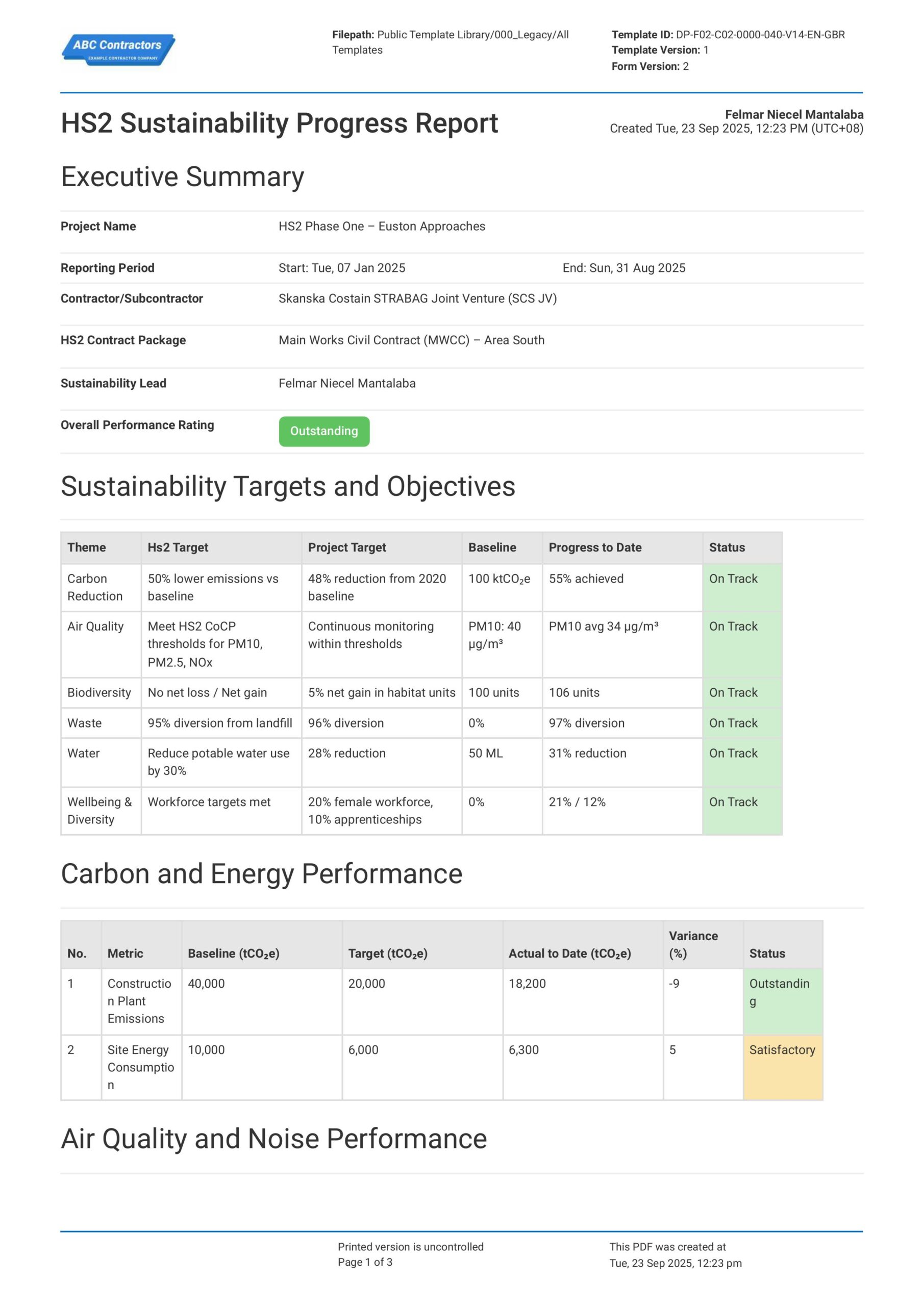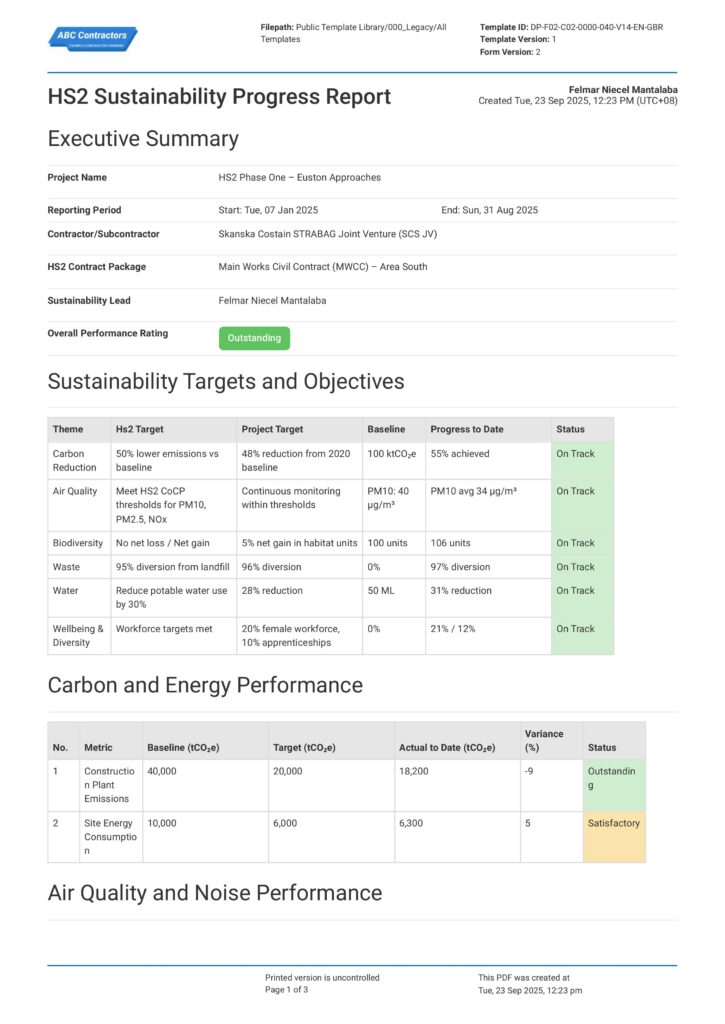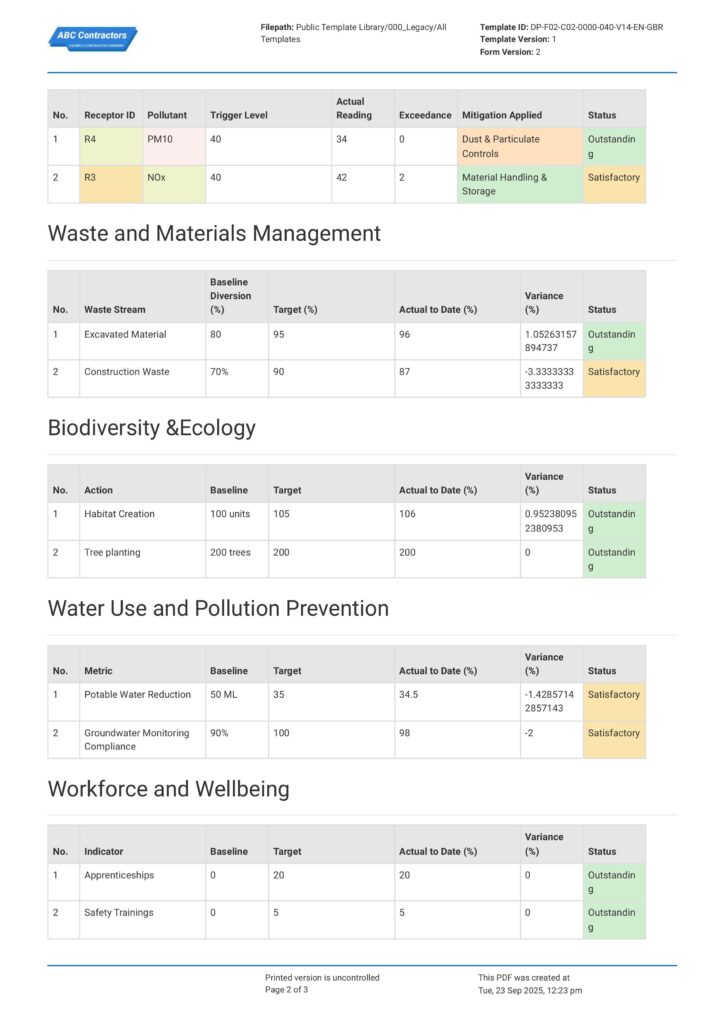Article Page – High Speed 2 (HS2) UK Project
High Speed 2 (HS2) UK Project
Discover the latest and most innovative project in the UK, the High Speed 2 Railway, to get ahead with current updates on construction. A HS2 Sustainability Progress Report, and other free reliable sources, are also shared in this article to help you streamline your HS2 processes.

Table of Contents
Article Summary
- The HS2, Britain's new high-speed train system, represents a significant advance in the country's critical transportation infrastructure. It will connect London and Birmingham, giving passengers more reliable, faster, and more frequent service.
- The HS2 project strongly places safety, environmental awareness, and long-term preservation as ts priorities across all stages and activities. As a result, a comprehensive HS2 Sustainability Progress Report aids in the implementation of safety measures.
- The High Speed 2 railway is one of the world's biggest infrastructure projects. The 140-mile railway between London and Birmingham intends to increase mobility, work and residential flexibility, and the UK's corporate sector.
What is the importance of the High Speed 2 (HS2) UK Project?
HS2, Britain's new high-speed railway, is a major innovation in the country's crucial transportation infrastructure. It will link London and Birmingham, providing passengers with more dependable, quicker, and more frequent services. HS2 trains will operate on zero-carbon power, contributing to the carbon reduction of the rail network. The new route will also free up capacity on the current network to accommodate rising passenger demand, allowing more room for local, regional, and freight services and removing vehicles from the road.
HS2 is Britain's largest infrastructure project, including the construction of massive structures such as tunnels, embankments, cuttings, bridges, and viaducts. Contracts are awarded to create HS2's rail infrastructure, including the tracks, signaling systems, and power supply, which will power the new trains.
HS2 is a critical component of the government's efforts to reconstruct Britain and boost the economy. By providing increased connectivity, the railway will enhance the economic growth in all areas between London and the West Midlands while also promoting social mobility. It also benefits businesses by providing easier access to trade and opportunities for expansion.
How to format your HS2 Sustainability Progress Report for your HS2 activities?
The HS2 project is critical when it comes to maintaining a safe and healthy working environment in all the involved phases and activities. Projects should be sustainable, safe for both workers and the environment.
A reliable sustainability progress report should help document the necessary measures and operations to meet projects as designed and in compliance with safety regulations. To better understand how a complete and compliant progress report should look, visit the example below.

Use this HS2 Sustainability Progress Report for free
What are the details of the High Speed 2 Route?
The High Speed 2 railway is considered one of the largest infrastructure projects in the world. The railway that stretches 140 miles from London to Birmingham aims to improve transportation, work and residential flexibility, and the business economy in the UK.
Complex planning is necessary for the construction of this megastructure, particularly for Traffic Management, as it will impact numerous roads and public areas. However, the HS2 aims to inform and assure people—both workers and civilians—of their continued convenience and safety.
High Speed 2 Stations
How many stops will HS2 have? The UK High Speed 2 railway includes multiple stations. However, there are four (4) main stations that serve strategic roles, which are as follows:
Euston Station: This major station of the south will be able to handle a significant flow of passengers to reduce congestion. The UK government has planned to build a 6-platform station that can handle the trains that will operate to Birmingham and beyond while also promoting local economic development.
Old Oak Common Station: This will be a new transportation superhub in West London, providing rapid and dependable travel to the Midlands, the North, and Scotland, as well as links to central London, the West Country, and South Wales.
Interchange Station: Interchange Station will be part of a new public transportation interchange for Solihull and the West Midlands. It will be one of the UK's best-connected areas, with access to local roads and the highway network.
Birmingham Curzon Street Station: Birmingham Curzon Street Station is intended to become an important destination and expanding departure point as part of Britain's new high-speed train network. The station will be the first new intercity terminal created in Britain, strengthening Birmingham's transportation linkages and supporting the rebuilding of Eastside and Digbeth.
HS2 UK Map
To give you a better idea of the modern High Speed 2 railway, here is a Map of the UK High Speed 2, which they have provided. The map depicts the important stations: Birmingham Curzon Street, Interchange in Solihull, Old Oak Common in west London, and London Euston. The map HS2 has provided contains elements that indicate the location of tunnels, viaducts, bridges, construction zones, and property schemes.
HS2 UK Route
The HS2 railway is designed to connect London with the major cities in the Midlands and the north. The phases of the project are the ones that primarily define the number of stops the HS2 railway has. Phase one of the project will run from London Euston to Birmingham Curzon Street, which passes through Hertfordshire, Buckinghamshire, and Warwickshire.
Phase 2 is divided into 2 phases, which are phase 2a and 2b. Phase 2a will stretch from Birmingham to Crewe, which links the West Midlands to Manchester Piccadilly. For phase 2B, the railway will split into two routes. The route from the west will run from Crewe to Manchester Piccadilly, and the eastern route will run from the West Midlands, pass the East Midlands and Sheffield, and finally to Leeds.
How long will HS2 take to get to London?
The UK HS2 railway will provide a prominent change in travel time. According to the figures provided by the Times, travel time from London to Birmingham will now take approximately 45 minutes, which is a 36-minute reduction from the previous duration, saving commuters and businesses significant amounts of time, money, and energy when the railways begin operating.
However, constructing the railway can provide the opposite impact. It can significantly affect and reduce transportation time in the areas where activities are taking place. To ease and manage traffic better, contractors should create a Traffic Control Plan. The plan can provide the surrounding community with convenient and alternative routes during construction, which eases traffic in the area and ensures the safety of pedestrians.
High Speed 2: An ingenious plan
UK HS2, Britain's planned high-speed line, is an important investment in the country's economic future and serves as the basis for a modern rail infrastructure. It will play an important role in rebuilding railroads, improving service reliability, and putting people first. UK HS2 will increase rail capacity, shorten trip times between each station, and generate employment and development.
HS2 project UK: A history
In the late 2000s, the UK had a growing problem with its railway system, which, in particular, pointed to congestion problems on the West Coast Main Line. To resolve this problem, the UK government established the HS2 Ltd. in 2009 to plan and engineer a new high-speed railway system. The very first proposal was submitted in 2010, which presents a line that links London to Birmingham and extensions from Manchester to Leeds. The High Speed Rail Act was approved by the parliament in 2017, and phase 1 of the construction between London and Birmingham began in 2020, which made history as the largest infrastructure project in the UK.
However, during the construction, multiple problems were encountered. The railway project faced numerous delays, the cost was continuously rising, and it sparked a huge political debate, which almost axed the entire project. Fortunately, despite all the controversy, the UK HS2 railway project rose above all the challenges it faced. The project did, however, undergo some changes. The lines from the eastern legs to Leeds and from Birmingham to Manchester will not be implemented. The new plan is to provide more focus on the London-Birmingham route and make railway improvements on the routes to Manchester. The UK government is hopeful about completing this project to provide passengers with a much more convenient and easy way of traveling.
Facts about HS2
The HS2 railway project is a fascinating piece of infrastructure. Aside from being a megastructure known worldwide, its engineering aspects can leave you in awe of the modern and innovative approaches taken, as well as the historic moments created during its progression. Here are the things you need to know about the High Speed 2 railway.
- The trains on the track can go up to a speed of 225 mph (360 kmph). That's faster than Formula Ones on some circuits.
- HS2 will be zero-carbon in operation. This means that they run entirely on electricity.
- The project has generated approximately 30,000 jobs, which includes internships for young, hopeful engineers.
- Tunnel boring machines used in constructing the project are so large, they almost measure up to 14 London buses.
- While working on planning the route, archaeologists have stumbled upon uncovered Roman settlements, medieval burial grounds, and Victorian artifacts.
What is HS2 in the UK?
HS2 is the UK's high-speed railway that connects London and Birmingham. British-built bullet trains will provide capacity, or space, to the overloaded network, allowing for speedier, zero-carbon travel between our two biggest cities.
The Department for Transport (DfT) formed HS2 Ltd to plan, construct, and operate High Speed Two (HS2), a high-speed railway between London and the West Midlands, with services connecting to the current rail network to serve destinations further north. HS2 Ltd is responsible for developing, building, and administering HS2's infrastructure, which includes a link to the West Coast Main Line at Handsacre near Lichfield, Staffordshire.
Cost of High Speed 2
The HS2 railway project is known to be one of the largest infrastructure projects in the UK, which includes new stations, ducts, tunnels, and bridges. This often leads us to be curious about how much the whole project will cost. Given the past controversies surrounding the project, we are left questioning whether it is worth the risk.
How much will HS2 cost?
To put it plainly, the HS2 railway project is a bank-breaker. As of April 2025, £37.9 billion has already been spent on phase 1 from London to Birmingham. Including the cancelled sections would result in a total expense of £40.5 billion. In the future years of 2026-2030, the UK government is estimated to spend around £25.3 billion for the HS2 railway project. Further current estimates show that the project will have spent £67–83 billion by 2030. The large increase is due to inflation, engineering challenges, and changes to the routes.
HS2 progress to date
The HS2 railway in the UK has been progressing steadily and efficiently. According to HS2, the construction has created 33,000 jobs, 45 miles of new rail tunnels have now been excavated, construction has started at 42 out of 52 major viaducts, construction has started at 122 out of 175 bridges, 8.21M m³ of 20.33M m³ has been excavated and placed to date, and current CEO, Mark Wild, is leading a complete plan review to reset the project and put it on a more sustainable path. This reset is about giving the government and taxpayers greater certainty around cost and delivery timelines.
When is the HS2 UK completion date?
The HS2 railway was expected to be finished in 2033, with phase 1 expected to operate in 2026. However, due to current delays and project challenges, the project is undergoing a complete plan review to reset its timeline, which has extended the completion date for phase one. As of right now, there has been no news about the new project completion target. The UK government is currently collaborating to identify more effective solutions to reduce delays and ensure the timely completion of targets and objectives.
A smarter way to manage safety in constructing the HS2
Constructing the HS2 railway requires a high-standard implementation of environmental awareness and consciousness to safety measures. An Environmental Planning App surely can assist in creating environmentally-conscious reports for HS2 projects. Another of the needed measures is to ensure that your employees are identifiable, competent, and skilled enough to work on the HS2 railway, which can be done by making a site induction. However, making site inductions the old-fashioned way can incur delays and errors, which can compromise the project and compliance.
However, with the most recent technology available, there is now an easier way to conduct site inductions. With the Site Induction App, you can make the induction process easier and more professional by sending your digital induction form to people to complete and submit before or when they arrive. Once a person completes and submits the induction form, it is automatically stored in the database and induction register in real time.
You can also access and complete site inductions from anywhere, using any device. This allows everyone to have constant and instant access to your site induction documents no matter where they are on the project site. Using this app allows more flexibility and efficiency when making and completing forms, streamlining the whole induction process.
Summary of High Speed 2 (HS2) UK Project
HS2 is Britain's greatest infrastructure project. It includes the building of gigantic structures such as tunnels, embankments, cuttings, bridges, and viaducts. However, due to current delays and project issues, the project is undergoing a comprehensive plan review and reset, which has resulted in an extension of the completion date. Integrating modern technologies into railway building processes, particularly when controlling safety, may assist in reducing delays. Using a more modern approach aids in simplifying laborious operations and effectively managing materials and resources.
Frequently Asked Questions
Is a Site Induction Register required for contractors working on the HS2 Railway?
Yes – this process is required under HS2 Environmental Minimum Requirements (EMRs) and CDM Regulations 2015 in the UK. You can easily comply with these regulations by ensuring all contractors complete the HS2 site induction before starting work, maintaining an up-to-date Site Induction Register, and regularly auditing the register for accuracy.
How is technology changing how people do Sustainability Reports?
Technology is transforming site inductions by replacing manual paperwork and in-person tracking with digital solutions like Dashpivot. Teams can now complete reports on any device, and ensure everyone meets current safety and compliance standards. This leads to faster onboarding, more accurate records, and safer, better-managed worksites.
Does Sitemate offer templates for streamlining porcesses during the construction of the HS2 railway?
Yes – Sitemate offers ready-to-use and editable templates that can also be edited for your workflow. Companies of all sizes in the construction industry are using these templates right now to streamline their processes during the construction of the HS2 railway.For real-world examples of how Sitemate has improved workflows, you can explore one of their case studies here AM1 Projects case study.
Related resources

HS2 Air Quality and Dust Monitoring Report
Streamline air quality and dust monitoring logs and inspections in the smart way.

HS2 Construction Noise and Vibration Methodology Report Template
Ensure HS2 projects meet environmental codes, creating safe workplaces.

HS2 Air Quality Strategy
Develop strategies on the go while on the field with this smart strategy form.


